Strategic Report: Aldi's Global Market and Digital Business Model
VerifiedAdded on 2024/05/17
|19
|3307
|409
Report
AI Summary
This report provides a comprehensive analysis of Aldi's global market and digital business strategies. It includes an organizational profile and industry analysis using Porter's Five Forces, PESTEL, SWOT, and Value Chain analyses. The report explores internationalization theory and cultural factors influencing Aldi's operations, marketing activities including segmentation, targeting, and branding, and consumer trends. Ethical issues and online activities are also examined, along with recommendations for improvement. The analysis aims to provide a holistic view of Aldi's strategic approach in the global market and its digital presence.
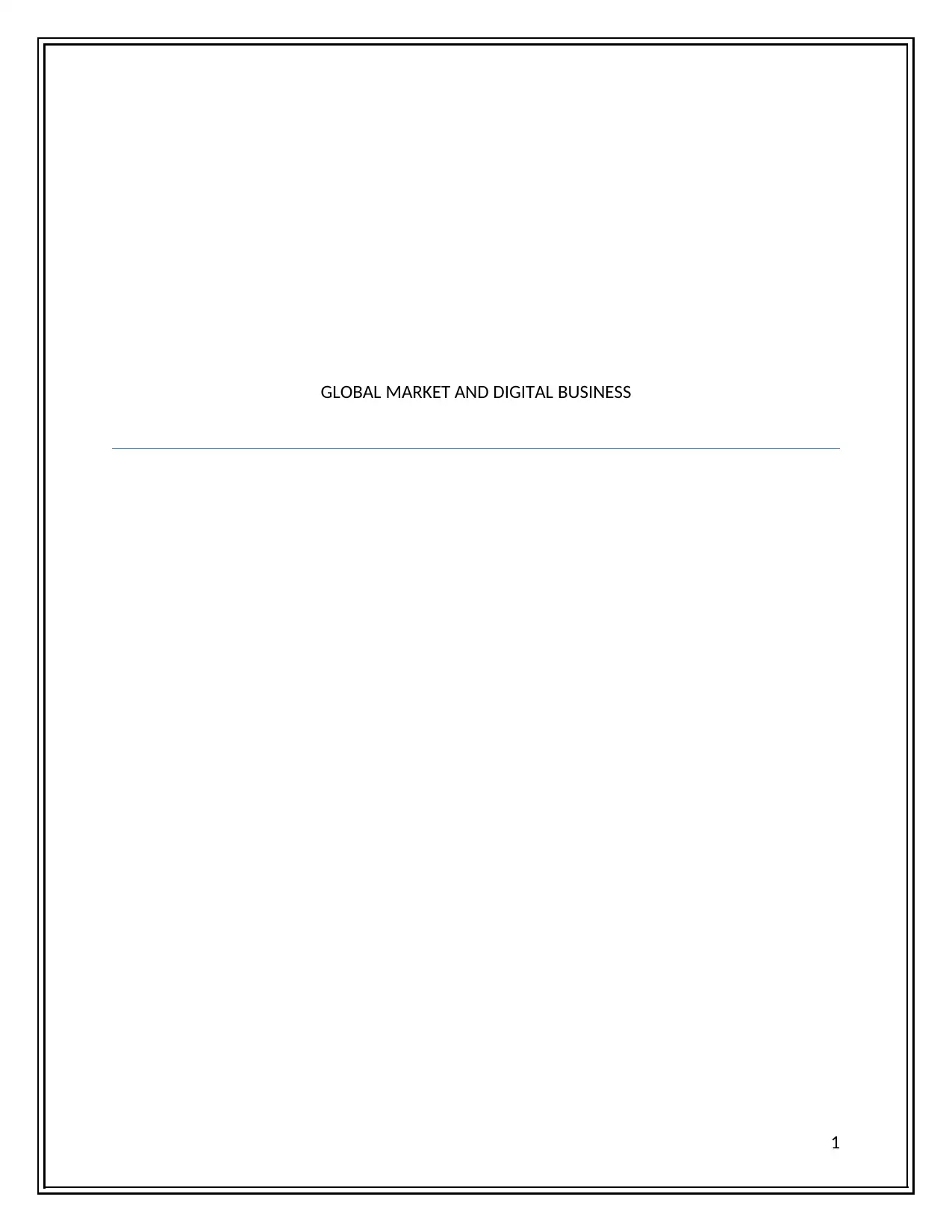
GLOBAL MARKET AND DIGITAL BUSINESS
1
1
Paraphrase This Document
Need a fresh take? Get an instant paraphrase of this document with our AI Paraphraser
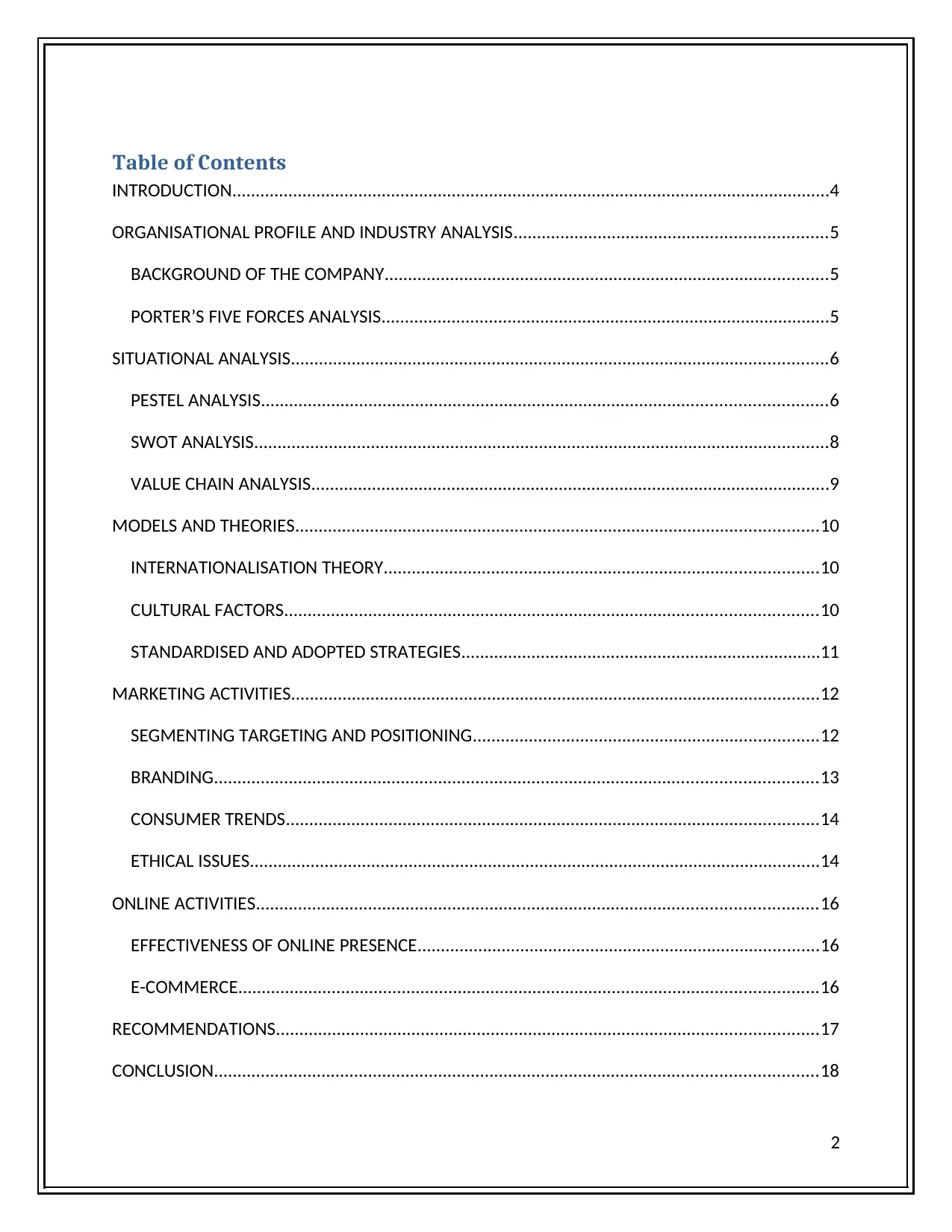
Table of Contents
INTRODUCTION................................................................................................................................4
ORGANISATIONAL PROFILE AND INDUSTRY ANALYSIS...................................................................5
BACKGROUND OF THE COMPANY...............................................................................................5
PORTER’S FIVE FORCES ANALYSIS................................................................................................5
SITUATIONAL ANALYSIS...................................................................................................................6
PESTEL ANALYSIS.........................................................................................................................6
SWOT ANALYSIS...........................................................................................................................8
VALUE CHAIN ANALYSIS...............................................................................................................9
MODELS AND THEORIES................................................................................................................10
INTERNATIONALISATION THEORY.............................................................................................10
CULTURAL FACTORS..................................................................................................................10
STANDARDISED AND ADOPTED STRATEGIES.............................................................................11
MARKETING ACTIVITIES.................................................................................................................12
SEGMENTING TARGETING AND POSITIONING..........................................................................12
BRANDING.................................................................................................................................13
CONSUMER TRENDS..................................................................................................................14
ETHICAL ISSUES..........................................................................................................................14
ONLINE ACTIVITIES........................................................................................................................16
EFFECTIVENESS OF ONLINE PRESENCE......................................................................................16
E-COMMERCE............................................................................................................................16
RECOMMENDATIONS....................................................................................................................17
CONCLUSION.................................................................................................................................18
2
INTRODUCTION................................................................................................................................4
ORGANISATIONAL PROFILE AND INDUSTRY ANALYSIS...................................................................5
BACKGROUND OF THE COMPANY...............................................................................................5
PORTER’S FIVE FORCES ANALYSIS................................................................................................5
SITUATIONAL ANALYSIS...................................................................................................................6
PESTEL ANALYSIS.........................................................................................................................6
SWOT ANALYSIS...........................................................................................................................8
VALUE CHAIN ANALYSIS...............................................................................................................9
MODELS AND THEORIES................................................................................................................10
INTERNATIONALISATION THEORY.............................................................................................10
CULTURAL FACTORS..................................................................................................................10
STANDARDISED AND ADOPTED STRATEGIES.............................................................................11
MARKETING ACTIVITIES.................................................................................................................12
SEGMENTING TARGETING AND POSITIONING..........................................................................12
BRANDING.................................................................................................................................13
CONSUMER TRENDS..................................................................................................................14
ETHICAL ISSUES..........................................................................................................................14
ONLINE ACTIVITIES........................................................................................................................16
EFFECTIVENESS OF ONLINE PRESENCE......................................................................................16
E-COMMERCE............................................................................................................................16
RECOMMENDATIONS....................................................................................................................17
CONCLUSION.................................................................................................................................18
2
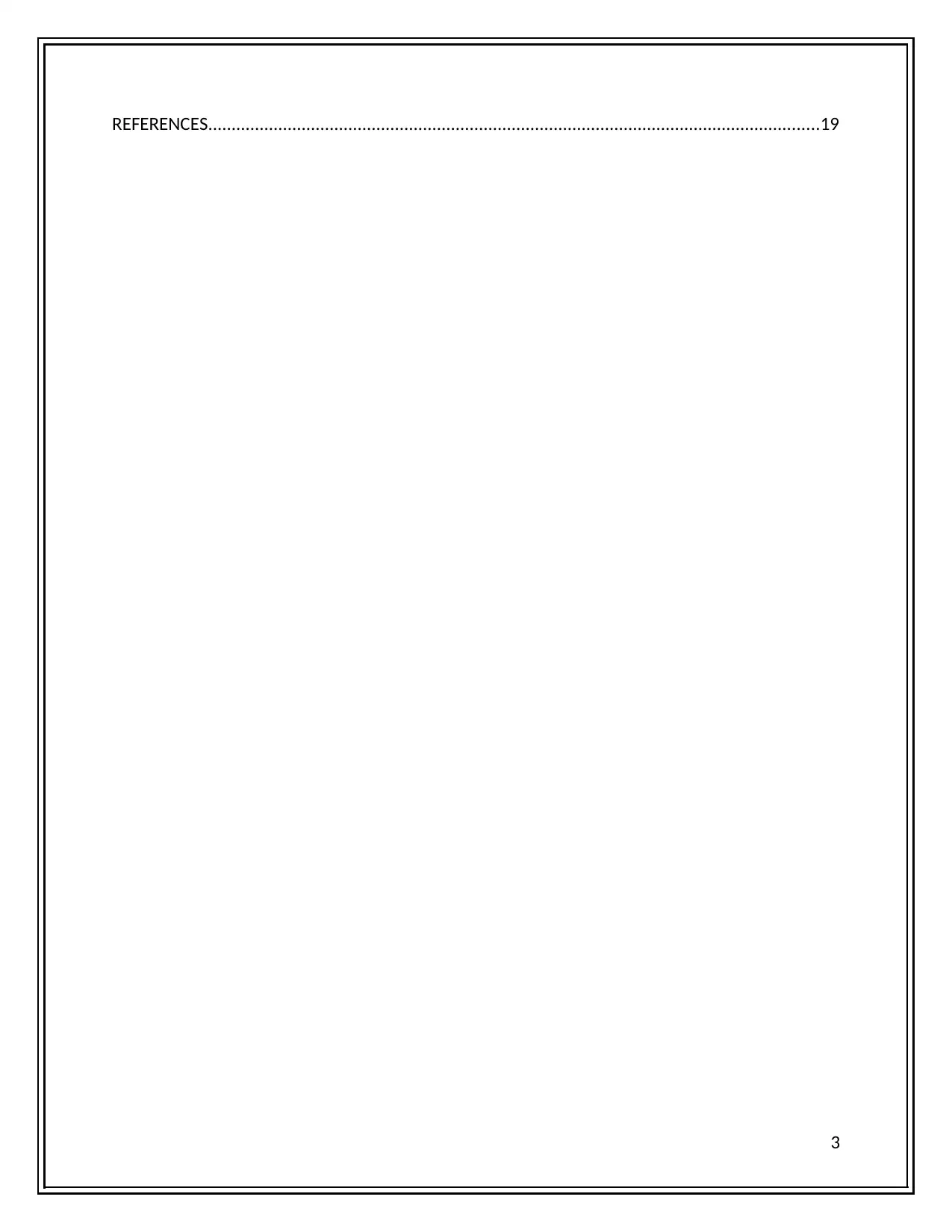
REFERENCES...................................................................................................................................19
3
3
⊘ This is a preview!⊘
Do you want full access?
Subscribe today to unlock all pages.

Trusted by 1+ million students worldwide
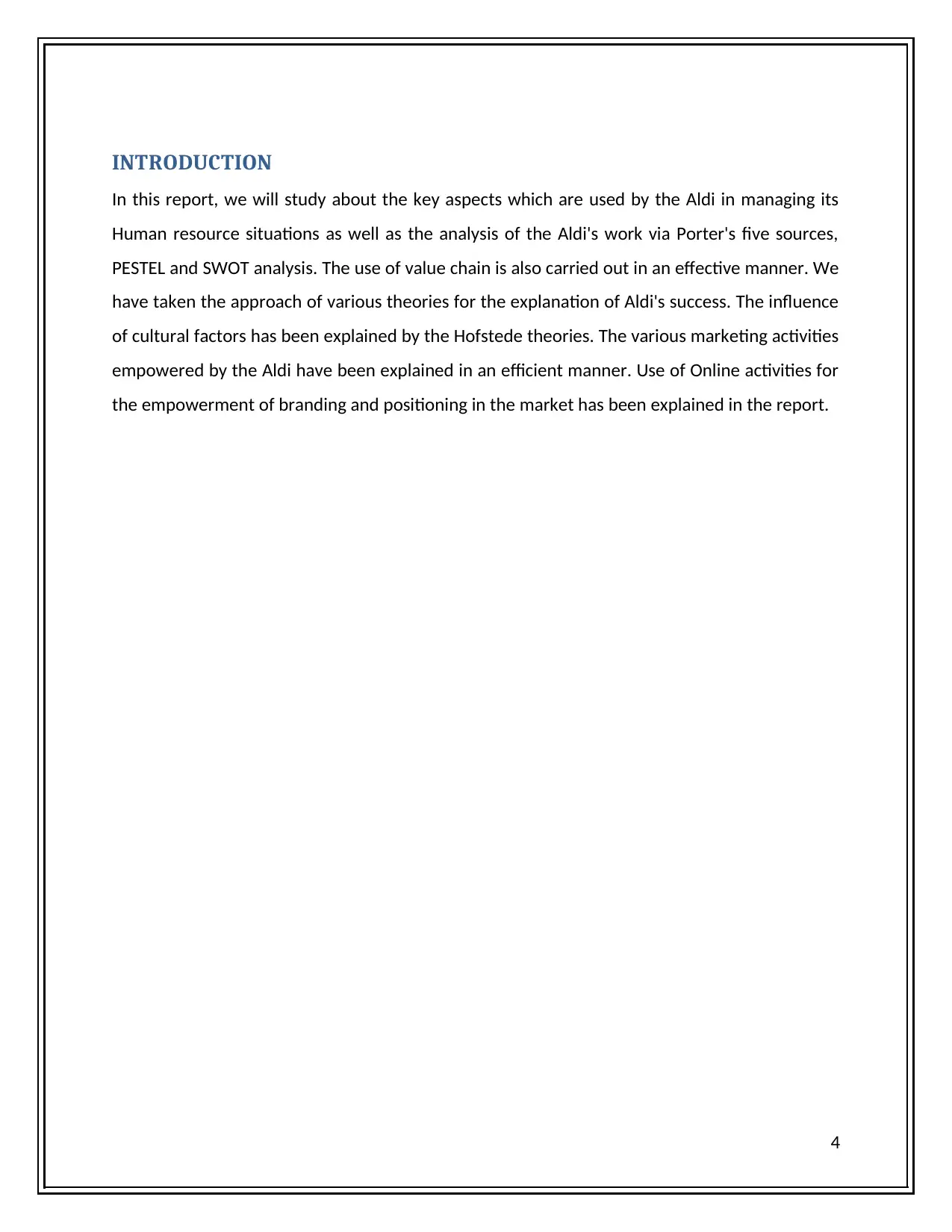
INTRODUCTION
In this report, we will study about the key aspects which are used by the Aldi in managing its
Human resource situations as well as the analysis of the Aldi's work via Porter's five sources,
PESTEL and SWOT analysis. The use of value chain is also carried out in an effective manner. We
have taken the approach of various theories for the explanation of Aldi's success. The influence
of cultural factors has been explained by the Hofstede theories. The various marketing activities
empowered by the Aldi have been explained in an efficient manner. Use of Online activities for
the empowerment of branding and positioning in the market has been explained in the report.
4
In this report, we will study about the key aspects which are used by the Aldi in managing its
Human resource situations as well as the analysis of the Aldi's work via Porter's five sources,
PESTEL and SWOT analysis. The use of value chain is also carried out in an effective manner. We
have taken the approach of various theories for the explanation of Aldi's success. The influence
of cultural factors has been explained by the Hofstede theories. The various marketing activities
empowered by the Aldi have been explained in an efficient manner. Use of Online activities for
the empowerment of branding and positioning in the market has been explained in the report.
4
Paraphrase This Document
Need a fresh take? Get an instant paraphrase of this document with our AI Paraphraser
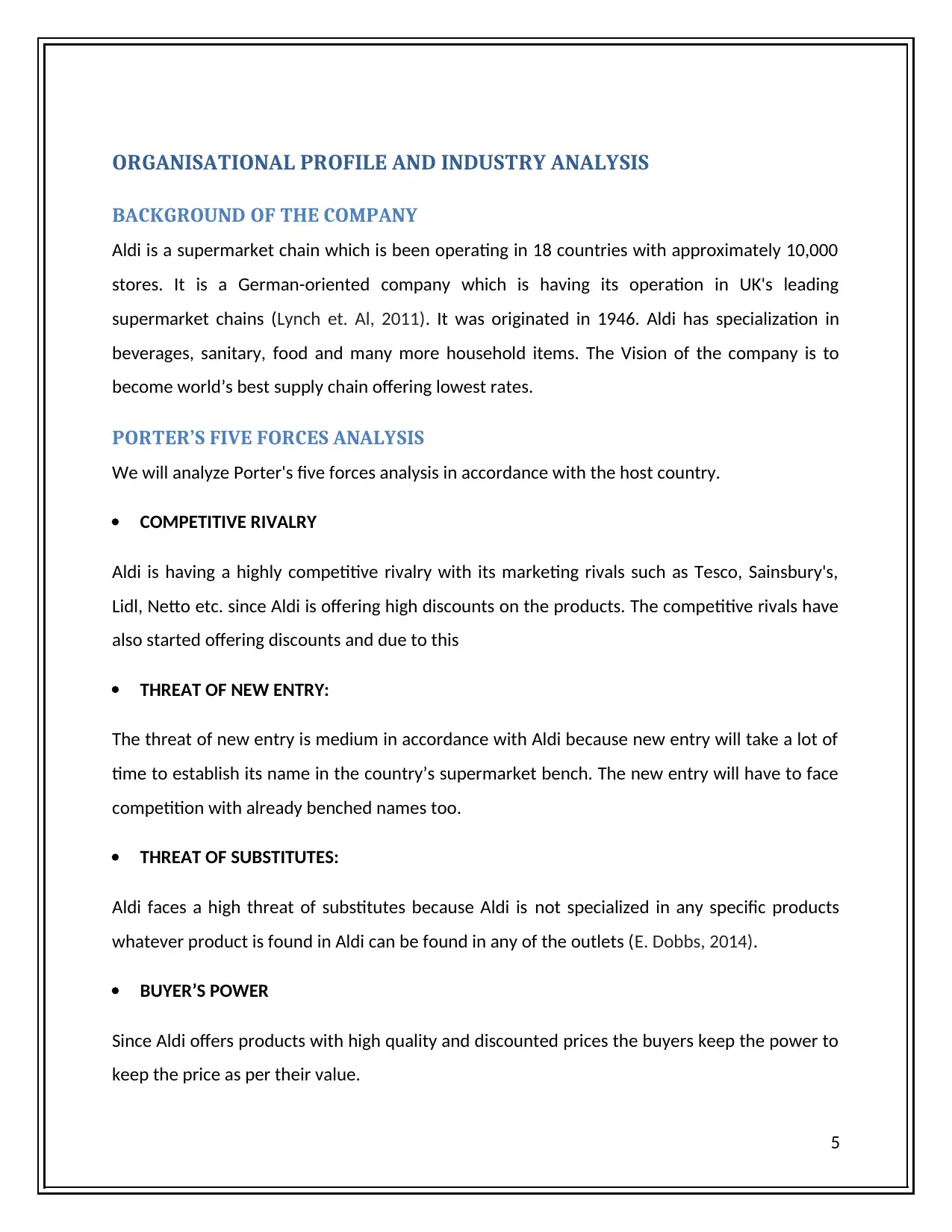
ORGANISATIONAL PROFILE AND INDUSTRY ANALYSIS
BACKGROUND OF THE COMPANY
Aldi is a supermarket chain which is been operating in 18 countries with approximately 10,000
stores. It is a German-oriented company which is having its operation in UK's leading
supermarket chains (Lynch et. Al, 2011). It was originated in 1946. Aldi has specialization in
beverages, sanitary, food and many more household items. The Vision of the company is to
become world’s best supply chain offering lowest rates.
PORTER’S FIVE FORCES ANALYSIS
We will analyze Porter's five forces analysis in accordance with the host country.
COMPETITIVE RIVALRY
Aldi is having a highly competitive rivalry with its marketing rivals such as Tesco, Sainsbury's,
Lidl, Netto etc. since Aldi is offering high discounts on the products. The competitive rivals have
also started offering discounts and due to this
THREAT OF NEW ENTRY:
The threat of new entry is medium in accordance with Aldi because new entry will take a lot of
time to establish its name in the country’s supermarket bench. The new entry will have to face
competition with already benched names too.
THREAT OF SUBSTITUTES:
Aldi faces a high threat of substitutes because Aldi is not specialized in any specific products
whatever product is found in Aldi can be found in any of the outlets (E. Dobbs, 2014).
BUYER’S POWER
Since Aldi offers products with high quality and discounted prices the buyers keep the power to
keep the price as per their value.
5
BACKGROUND OF THE COMPANY
Aldi is a supermarket chain which is been operating in 18 countries with approximately 10,000
stores. It is a German-oriented company which is having its operation in UK's leading
supermarket chains (Lynch et. Al, 2011). It was originated in 1946. Aldi has specialization in
beverages, sanitary, food and many more household items. The Vision of the company is to
become world’s best supply chain offering lowest rates.
PORTER’S FIVE FORCES ANALYSIS
We will analyze Porter's five forces analysis in accordance with the host country.
COMPETITIVE RIVALRY
Aldi is having a highly competitive rivalry with its marketing rivals such as Tesco, Sainsbury's,
Lidl, Netto etc. since Aldi is offering high discounts on the products. The competitive rivals have
also started offering discounts and due to this
THREAT OF NEW ENTRY:
The threat of new entry is medium in accordance with Aldi because new entry will take a lot of
time to establish its name in the country’s supermarket bench. The new entry will have to face
competition with already benched names too.
THREAT OF SUBSTITUTES:
Aldi faces a high threat of substitutes because Aldi is not specialized in any specific products
whatever product is found in Aldi can be found in any of the outlets (E. Dobbs, 2014).
BUYER’S POWER
Since Aldi offers products with high quality and discounted prices the buyers keep the power to
keep the price as per their value.
5
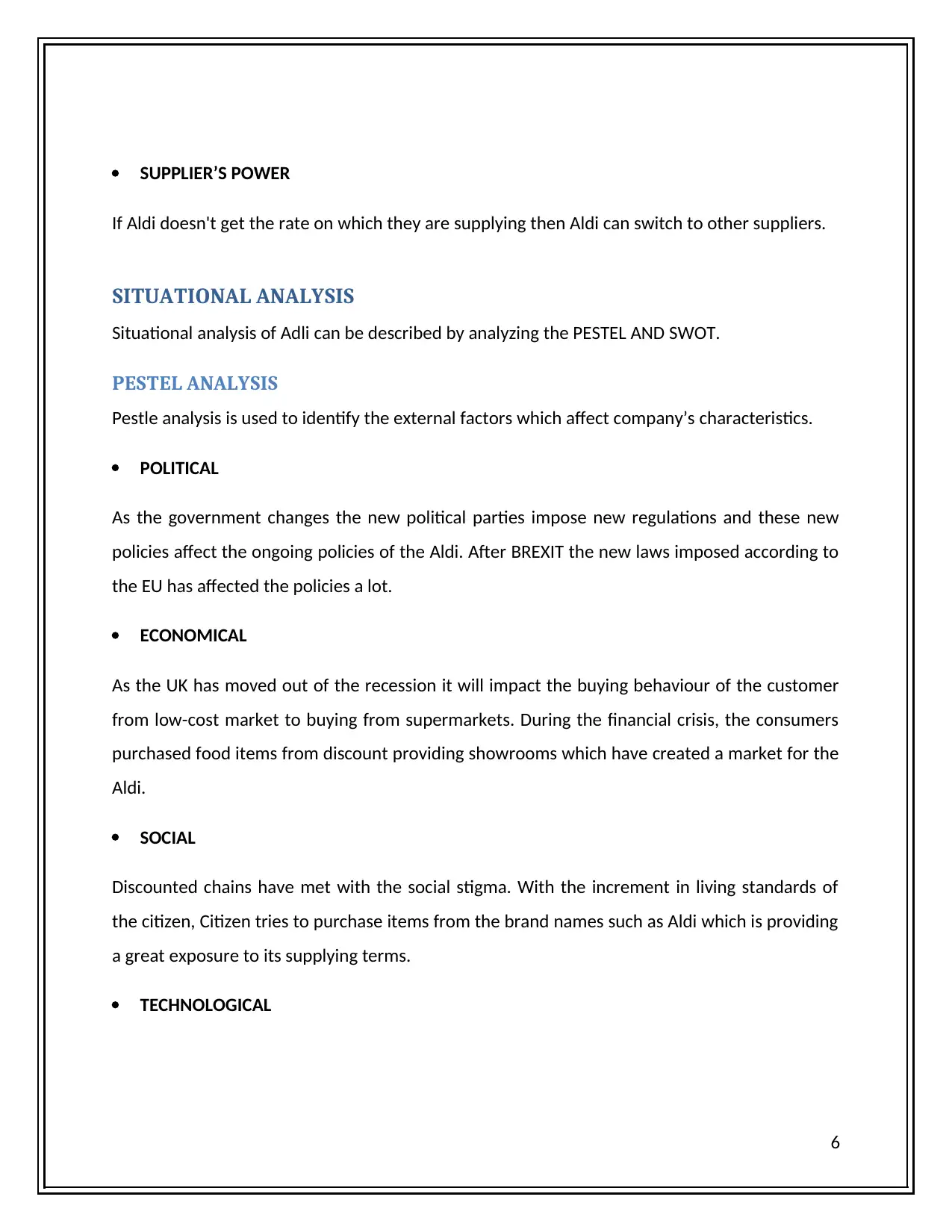
SUPPLIER’S POWER
If Aldi doesn't get the rate on which they are supplying then Aldi can switch to other suppliers.
SITUATIONAL ANALYSIS
Situational analysis of Adli can be described by analyzing the PESTEL AND SWOT.
PESTEL ANALYSIS
Pestle analysis is used to identify the external factors which affect company’s characteristics.
POLITICAL
As the government changes the new political parties impose new regulations and these new
policies affect the ongoing policies of the Aldi. After BREXIT the new laws imposed according to
the EU has affected the policies a lot.
ECONOMICAL
As the UK has moved out of the recession it will impact the buying behaviour of the customer
from low-cost market to buying from supermarkets. During the financial crisis, the consumers
purchased food items from discount providing showrooms which have created a market for the
Aldi.
SOCIAL
Discounted chains have met with the social stigma. With the increment in living standards of
the citizen, Citizen tries to purchase items from the brand names such as Aldi which is providing
a great exposure to its supplying terms.
TECHNOLOGICAL
6
If Aldi doesn't get the rate on which they are supplying then Aldi can switch to other suppliers.
SITUATIONAL ANALYSIS
Situational analysis of Adli can be described by analyzing the PESTEL AND SWOT.
PESTEL ANALYSIS
Pestle analysis is used to identify the external factors which affect company’s characteristics.
POLITICAL
As the government changes the new political parties impose new regulations and these new
policies affect the ongoing policies of the Aldi. After BREXIT the new laws imposed according to
the EU has affected the policies a lot.
ECONOMICAL
As the UK has moved out of the recession it will impact the buying behaviour of the customer
from low-cost market to buying from supermarkets. During the financial crisis, the consumers
purchased food items from discount providing showrooms which have created a market for the
Aldi.
SOCIAL
Discounted chains have met with the social stigma. With the increment in living standards of
the citizen, Citizen tries to purchase items from the brand names such as Aldi which is providing
a great exposure to its supplying terms.
TECHNOLOGICAL
6
⊘ This is a preview!⊘
Do you want full access?
Subscribe today to unlock all pages.

Trusted by 1+ million students worldwide
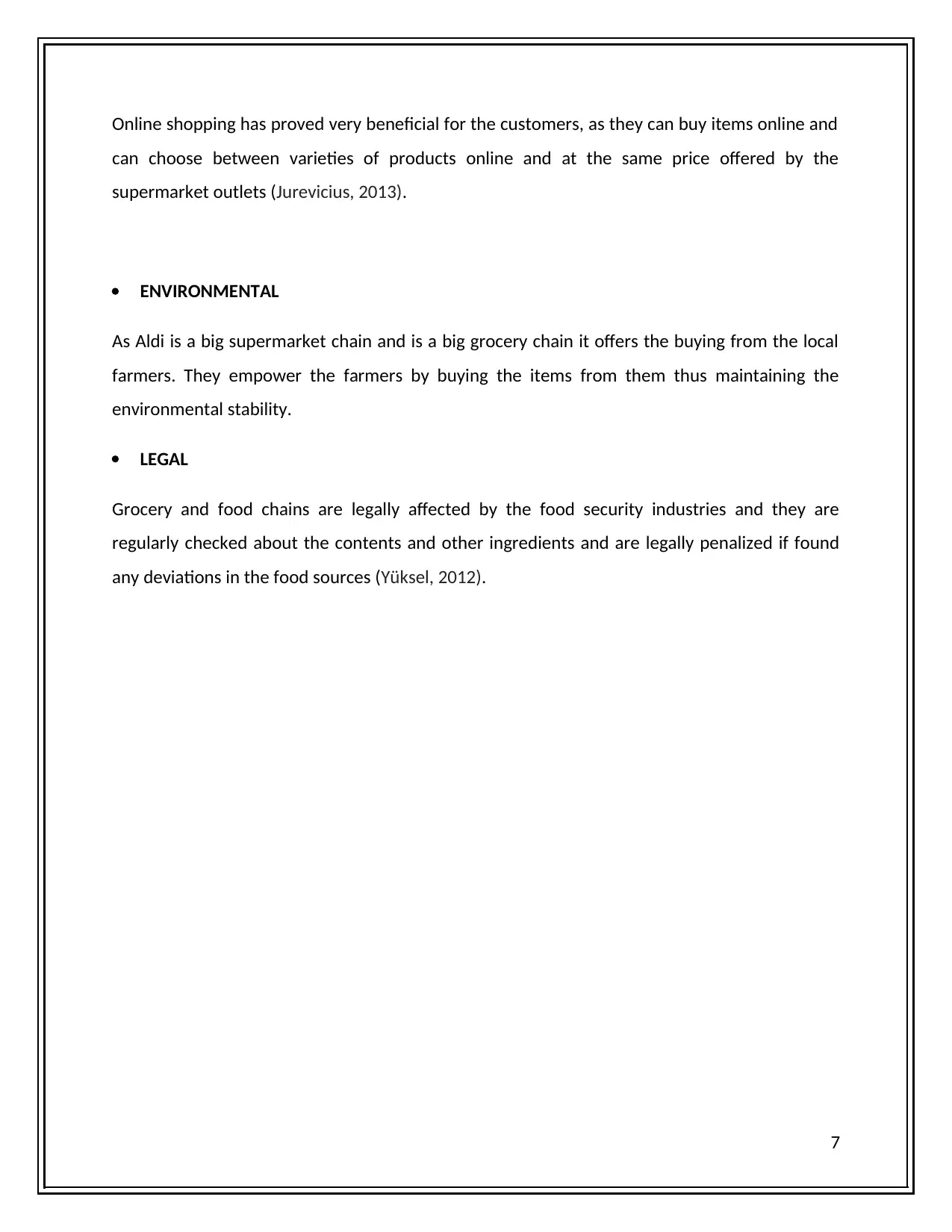
Online shopping has proved very beneficial for the customers, as they can buy items online and
can choose between varieties of products online and at the same price offered by the
supermarket outlets (Jurevicius, 2013).
ENVIRONMENTAL
As Aldi is a big supermarket chain and is a big grocery chain it offers the buying from the local
farmers. They empower the farmers by buying the items from them thus maintaining the
environmental stability.
LEGAL
Grocery and food chains are legally affected by the food security industries and they are
regularly checked about the contents and other ingredients and are legally penalized if found
any deviations in the food sources (Yüksel, 2012).
7
can choose between varieties of products online and at the same price offered by the
supermarket outlets (Jurevicius, 2013).
ENVIRONMENTAL
As Aldi is a big supermarket chain and is a big grocery chain it offers the buying from the local
farmers. They empower the farmers by buying the items from them thus maintaining the
environmental stability.
LEGAL
Grocery and food chains are legally affected by the food security industries and they are
regularly checked about the contents and other ingredients and are legally penalized if found
any deviations in the food sources (Yüksel, 2012).
7
Paraphrase This Document
Need a fresh take? Get an instant paraphrase of this document with our AI Paraphraser
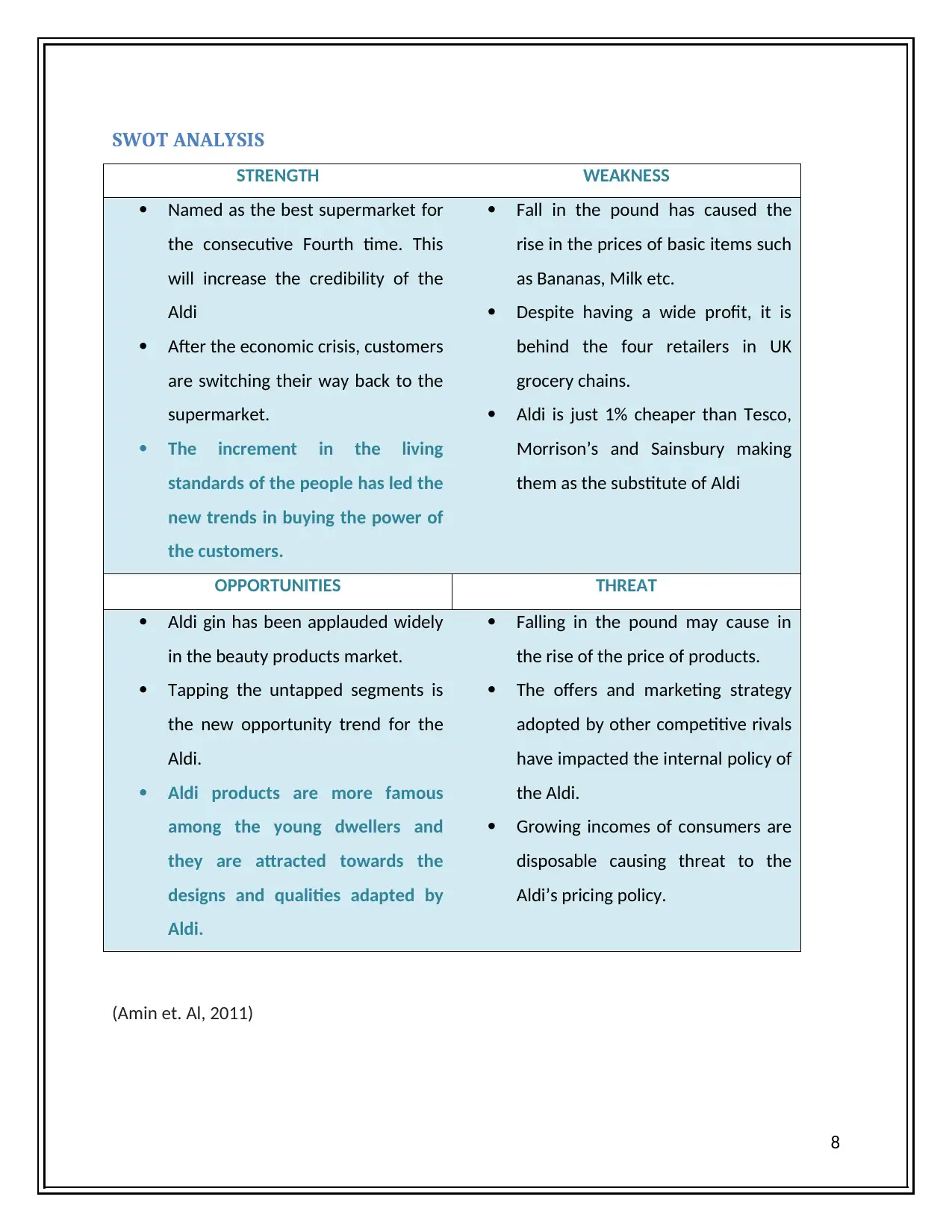
SWOT ANALYSIS
STRENGTH WEAKNESS
Named as the best supermarket for
the consecutive Fourth time. This
will increase the credibility of the
Aldi
After the economic crisis, customers
are switching their way back to the
supermarket.
The increment in the living
standards of the people has led the
new trends in buying the power of
the customers.
Fall in the pound has caused the
rise in the prices of basic items such
as Bananas, Milk etc.
Despite having a wide profit, it is
behind the four retailers in UK
grocery chains.
Aldi is just 1% cheaper than Tesco,
Morrison’s and Sainsbury making
them as the substitute of Aldi
OPPORTUNITIES THREAT
Aldi gin has been applauded widely
in the beauty products market.
Tapping the untapped segments is
the new opportunity trend for the
Aldi.
Aldi products are more famous
among the young dwellers and
they are attracted towards the
designs and qualities adapted by
Aldi.
Falling in the pound may cause in
the rise of the price of products.
The offers and marketing strategy
adopted by other competitive rivals
have impacted the internal policy of
the Aldi.
Growing incomes of consumers are
disposable causing threat to the
Aldi’s pricing policy.
(Amin et. Al, 2011)
8
STRENGTH WEAKNESS
Named as the best supermarket for
the consecutive Fourth time. This
will increase the credibility of the
Aldi
After the economic crisis, customers
are switching their way back to the
supermarket.
The increment in the living
standards of the people has led the
new trends in buying the power of
the customers.
Fall in the pound has caused the
rise in the prices of basic items such
as Bananas, Milk etc.
Despite having a wide profit, it is
behind the four retailers in UK
grocery chains.
Aldi is just 1% cheaper than Tesco,
Morrison’s and Sainsbury making
them as the substitute of Aldi
OPPORTUNITIES THREAT
Aldi gin has been applauded widely
in the beauty products market.
Tapping the untapped segments is
the new opportunity trend for the
Aldi.
Aldi products are more famous
among the young dwellers and
they are attracted towards the
designs and qualities adapted by
Aldi.
Falling in the pound may cause in
the rise of the price of products.
The offers and marketing strategy
adopted by other competitive rivals
have impacted the internal policy of
the Aldi.
Growing incomes of consumers are
disposable causing threat to the
Aldi’s pricing policy.
(Amin et. Al, 2011)
8
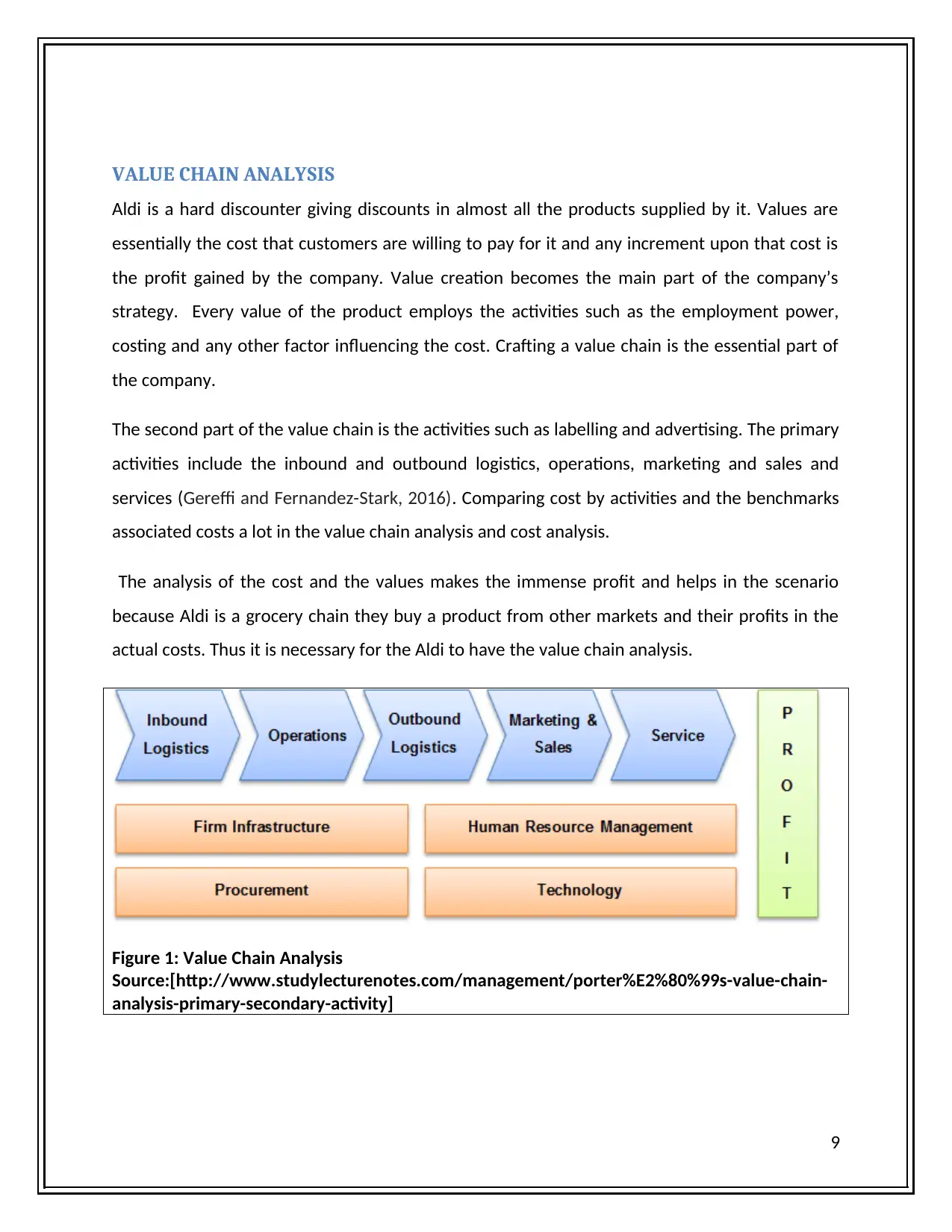
VALUE CHAIN ANALYSIS
Aldi is a hard discounter giving discounts in almost all the products supplied by it. Values are
essentially the cost that customers are willing to pay for it and any increment upon that cost is
the profit gained by the company. Value creation becomes the main part of the company’s
strategy. Every value of the product employs the activities such as the employment power,
costing and any other factor influencing the cost. Crafting a value chain is the essential part of
the company.
The second part of the value chain is the activities such as labelling and advertising. The primary
activities include the inbound and outbound logistics, operations, marketing and sales and
services (Gereffi and Fernandez-Stark, 2016). Comparing cost by activities and the benchmarks
associated costs a lot in the value chain analysis and cost analysis.
The analysis of the cost and the values makes the immense profit and helps in the scenario
because Aldi is a grocery chain they buy a product from other markets and their profits in the
actual costs. Thus it is necessary for the Aldi to have the value chain analysis.
Figure 1: Value Chain Analysis
Source:[http://www.studylecturenotes.com/management/porter%E2%80%99s-value-chain-
analysis-primary-secondary-activity]
9
Aldi is a hard discounter giving discounts in almost all the products supplied by it. Values are
essentially the cost that customers are willing to pay for it and any increment upon that cost is
the profit gained by the company. Value creation becomes the main part of the company’s
strategy. Every value of the product employs the activities such as the employment power,
costing and any other factor influencing the cost. Crafting a value chain is the essential part of
the company.
The second part of the value chain is the activities such as labelling and advertising. The primary
activities include the inbound and outbound logistics, operations, marketing and sales and
services (Gereffi and Fernandez-Stark, 2016). Comparing cost by activities and the benchmarks
associated costs a lot in the value chain analysis and cost analysis.
The analysis of the cost and the values makes the immense profit and helps in the scenario
because Aldi is a grocery chain they buy a product from other markets and their profits in the
actual costs. Thus it is necessary for the Aldi to have the value chain analysis.
Figure 1: Value Chain Analysis
Source:[http://www.studylecturenotes.com/management/porter%E2%80%99s-value-chain-
analysis-primary-secondary-activity]
9
⊘ This is a preview!⊘
Do you want full access?
Subscribe today to unlock all pages.

Trusted by 1+ million students worldwide

10
Paraphrase This Document
Need a fresh take? Get an instant paraphrase of this document with our AI Paraphraser
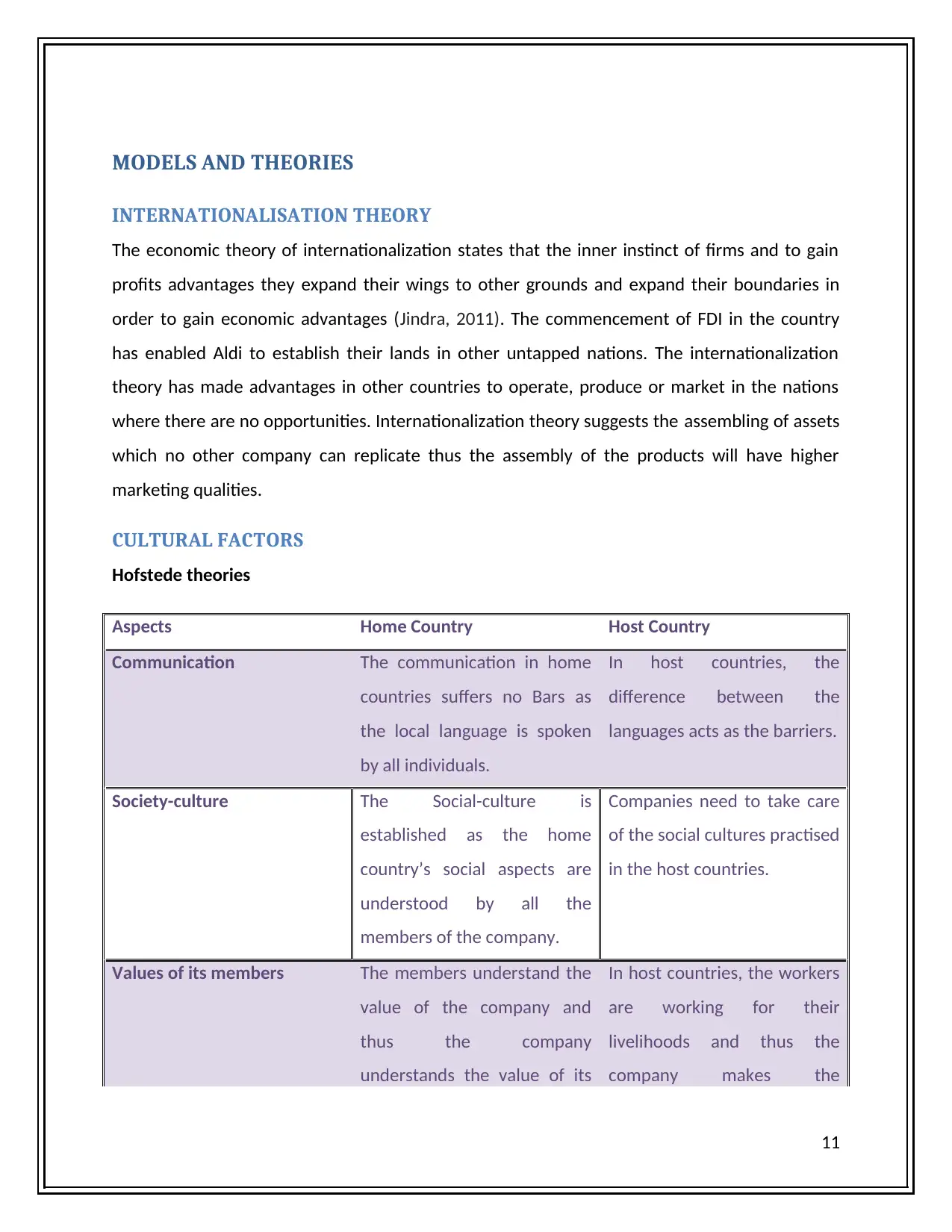
MODELS AND THEORIES
INTERNATIONALISATION THEORY
The economic theory of internationalization states that the inner instinct of firms and to gain
profits advantages they expand their wings to other grounds and expand their boundaries in
order to gain economic advantages (Jindra, 2011). The commencement of FDI in the country
has enabled Aldi to establish their lands in other untapped nations. The internationalization
theory has made advantages in other countries to operate, produce or market in the nations
where there are no opportunities. Internationalization theory suggests the assembling of assets
which no other company can replicate thus the assembly of the products will have higher
marketing qualities.
CULTURAL FACTORS
Hofstede theories
Aspects Home Country Host Country
Communication The communication in home
countries suffers no Bars as
the local language is spoken
by all individuals.
In host countries, the
difference between the
languages acts as the barriers.
Society-culture The Social-culture is
established as the home
country’s social aspects are
understood by all the
members of the company.
Companies need to take care
of the social cultures practised
in the host countries.
Values of its members The members understand the
value of the company and
thus the company
understands the value of its
In host countries, the workers
are working for their
livelihoods and thus the
company makes the
11
INTERNATIONALISATION THEORY
The economic theory of internationalization states that the inner instinct of firms and to gain
profits advantages they expand their wings to other grounds and expand their boundaries in
order to gain economic advantages (Jindra, 2011). The commencement of FDI in the country
has enabled Aldi to establish their lands in other untapped nations. The internationalization
theory has made advantages in other countries to operate, produce or market in the nations
where there are no opportunities. Internationalization theory suggests the assembling of assets
which no other company can replicate thus the assembly of the products will have higher
marketing qualities.
CULTURAL FACTORS
Hofstede theories
Aspects Home Country Host Country
Communication The communication in home
countries suffers no Bars as
the local language is spoken
by all individuals.
In host countries, the
difference between the
languages acts as the barriers.
Society-culture The Social-culture is
established as the home
country’s social aspects are
understood by all the
members of the company.
Companies need to take care
of the social cultures practised
in the host countries.
Values of its members The members understand the
value of the company and
thus the company
understands the value of its
In host countries, the workers
are working for their
livelihoods and thus the
company makes the
11
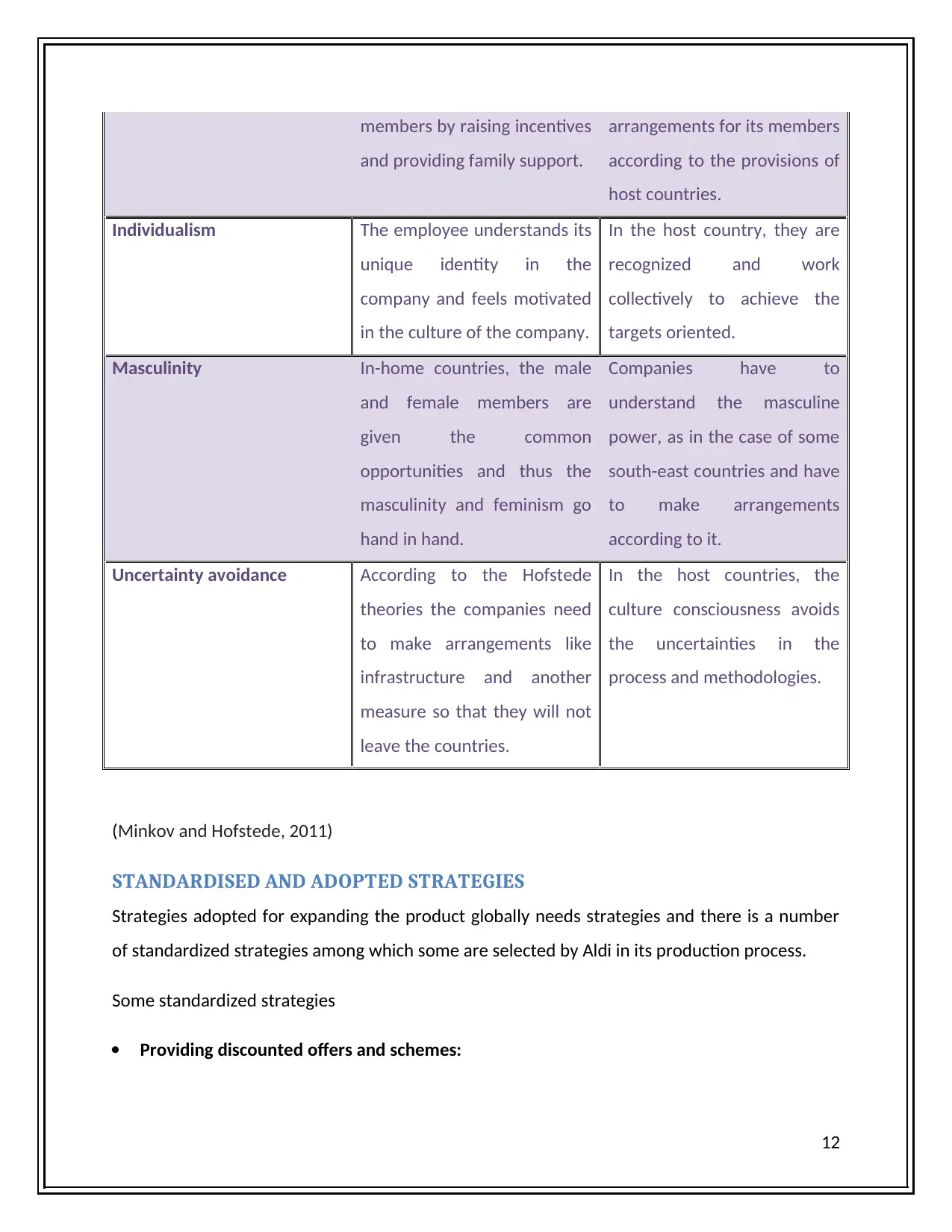
members by raising incentives
and providing family support.
arrangements for its members
according to the provisions of
host countries.
Individualism The employee understands its
unique identity in the
company and feels motivated
in the culture of the company.
In the host country, they are
recognized and work
collectively to achieve the
targets oriented.
Masculinity In-home countries, the male
and female members are
given the common
opportunities and thus the
masculinity and feminism go
hand in hand.
Companies have to
understand the masculine
power, as in the case of some
south-east countries and have
to make arrangements
according to it.
Uncertainty avoidance According to the Hofstede
theories the companies need
to make arrangements like
infrastructure and another
measure so that they will not
leave the countries.
In the host countries, the
culture consciousness avoids
the uncertainties in the
process and methodologies.
(Minkov and Hofstede, 2011)
STANDARDISED AND ADOPTED STRATEGIES
Strategies adopted for expanding the product globally needs strategies and there is a number
of standardized strategies among which some are selected by Aldi in its production process.
Some standardized strategies
Providing discounted offers and schemes:
12
and providing family support.
arrangements for its members
according to the provisions of
host countries.
Individualism The employee understands its
unique identity in the
company and feels motivated
in the culture of the company.
In the host country, they are
recognized and work
collectively to achieve the
targets oriented.
Masculinity In-home countries, the male
and female members are
given the common
opportunities and thus the
masculinity and feminism go
hand in hand.
Companies have to
understand the masculine
power, as in the case of some
south-east countries and have
to make arrangements
according to it.
Uncertainty avoidance According to the Hofstede
theories the companies need
to make arrangements like
infrastructure and another
measure so that they will not
leave the countries.
In the host countries, the
culture consciousness avoids
the uncertainties in the
process and methodologies.
(Minkov and Hofstede, 2011)
STANDARDISED AND ADOPTED STRATEGIES
Strategies adopted for expanding the product globally needs strategies and there is a number
of standardized strategies among which some are selected by Aldi in its production process.
Some standardized strategies
Providing discounted offers and schemes:
12
⊘ This is a preview!⊘
Do you want full access?
Subscribe today to unlock all pages.

Trusted by 1+ million students worldwide
1 out of 19
Related Documents
Your All-in-One AI-Powered Toolkit for Academic Success.
+13062052269
info@desklib.com
Available 24*7 on WhatsApp / Email
![[object Object]](/_next/static/media/star-bottom.7253800d.svg)
Unlock your academic potential
Copyright © 2020–2025 A2Z Services. All Rights Reserved. Developed and managed by ZUCOL.



